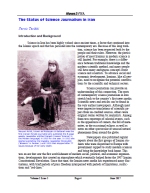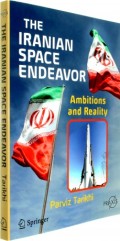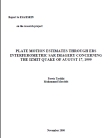Pioneering to space with Omid
Parviz Tarikhi
“On February 2nd, 2009 we successfully launched our first domestic Satellite Launch Vehicle (SLV) named Safir-2 carrying our first domestic telecommunication satellite called Omid and injected the satellite in LEO,” said the president of the Iranian Space Agency (ISA) in a report on Omid satellite launch that gave to the 46th Meeting of the Scientific and Technical Subcommittee of the Committee on the Peaceful Uses of Outer Space (COPUOS) held from 9th to 20th February 2009 in Vienna, Austria. He added, “This is definitely a great step forward toward[s] development in space technology. I would like to inform you that all the work from design to manufacturing to test and operation of the satellite and its launch vehicle has been done by Iranian experts and engineers.”
“Omid” that stands for “hope” in Persian language is indeed the first Iranian home-built satellite which is launched by a domestic launcher. This puts Iran in the club of nine countries that benefit their own independent satellite launching and manufacturing capacities. The former Soviet Union launched the world’s first artificial satellite, Sputnik-1, in October 1957. USA was the next with the successful launch of Explorer-1 in January 1958. France, Japan, China, UK, India and Israel later developed and successfully flew their own space launchers. Iran is the first new space-faring country since Israel joined the club in 1988.
Omid which its design and manufacturing began in February 2006 is indeed a store and forward telecommunication satellite of 40cm cubic size that weighs 27 kg. Its thermal control is passive and works in UHF band. Satellite’s nodal period is 90.7 minuets with the inclination of 55.71 degree. Omid’s apogee is 381.2 km while its perigee is 245.5 km.
Since the Omid project was the first step in building an indigenous satellite, therefore the most important and complicated task prior to producing a domestic product was to set up the needed infrastructure for satellite industry.
Development of Omid was carried out through different phases that includes setting up the satellite’s electronics, building the space receiver and transmitter, quality systems management, thermal vacuum testing, environmental tests for quality assurance, set up the space GPS for tracking, mounting of the ranging facility, satellite flight simulation, space system engineering, satellite in-orbit operation, period and satellite rise assessment, and necessary software development.
The main achievements of Omid project has been manufacturing the first domestic space system, acquiring space technology to drive other industries, persuading the academia for cooperation and contribution to the development of space technologies, capacity building in satellite manufacturing, integration and test, cooperation with private sector, interaction between launcher, satellite and ground stations, design and manufacturing of the first domestic telemetry, tracking and command (TT&C) station, design and implementation of satellite monitoring and control, and telemetry coding and decoding as well as satellite tracking softwares.
Safir-2 is the first Iranian domestic SLV for carrying light weight satellites up to low Earth orbit (LEO). With the perigee and apogee of 250 km and 500 km respectively, Safir-2 is of 22m length with the diameter of 1.25m while it weighs more than 26 tons. The mission of Safir-2 was to place Omid in the orbit of 250km.
Achievement of SLV technology followed by the technologies including system engineering, conceptual design, preliminary design, simulation, detail and critical design, integration and test, and quality assurance. Engine development technology included manufacturing the first stage engine which was capable of reaching to the maximum altitude of 68km and then development of the second stage engine to carry the maximum payload of 27 kg and angle correction for final payload shooting.
For structure development the high thermal and mechanical resistances were experienced. Working with propellant technology created the base for the propellant production industries. Through the control and navigation technologies Iran gained experience in flight simulation, navigation systems, power sources, power storage, actuators, barometers, cabling and testers. Develop of the velocity and acceleration sensors are amongst the achievements in sensor technologies that also required expertise in application of navigation systems. On launch pad technology good experience was gained in logistics, accessories, transport vehicles, launch tower, launcher integration and test, propellant charging, and launcher flight control station.
Omid’s ground stations network includes three tracking, telemetry and command stations, three TT&C, one central flight control station, four ranging stations and the ground receiving stations and terminals.
According to ISA’s president, space technologies are amongst those sophisticated and expensive technologies that has been achieved by only a limited number of countries and Iran tries to attain independence in development of space services in course of its V and VI five-year Development Plans.
There is seen a considerable enthusiasm for design and manufacturing micro and nano-satellites at the country particularly the ones that are designed in academic and research institutions with different missions. However, there are also plans for larger satellites. “The satellites are designed to be used for the management [and monitoring] of natural disasters, earthquakes, natural resources, agriculture, etc., and in this connection three satellite design and manufacturing programs has begun jointly with three leading technical universities of Iran Amirkabir University of Technology (AUT), Iran University of Science and Technology (IUST), and Sharif University of Technology (SUT) which the finance allocated for each program exceeds to about US$10 million,” says ISA’s president.
The fourth five-year Development Plan concludes in 2009. High priority has been given to space technology applications as the effective tool for the sustainable development of the country. In the mean time, according to the twenty-year Vision Decree of the country, issued on November 4, 2002 by the leader of the Islamic Republic of Iran, potentials and capacities throughout the country should be focused to increase Iran’s contribution to global scientific production. In this connection, Iran should gain access, in particular to new technologies including nanotechnology, biotechnology, information and communication technology, environmental technology, and aerospace and nuclear technology. At the end of the twenty-year Development Plan, in 2025, it is expected that Iran has become the number one country in applications and development of space technology in the Middle East region.
Satellite-based remote sensing is one of ISA’s top priorities. The idea of having self-owned satellites to secure the needs of the country for remote sensing data in addition to other demands including communications and broadcasting is also considered as important. The international professional cooperation and exchange is indeed a key factor in developing the satellites. It has been always regarded as important and vital while it is hoped that will be followed up in the future.
Based on the official announcements Omid’s mission was concluded on 24 March 2009, 50 days after its launch. However, reentry of the satellite to the atmosphere has not announced officially but the calculations tell that Omid enters the atmosphere mid-April 2009 while the second stage of the Safir-2 would decay before the end of May 2009. Although Omid is an experimental satellite with short-term mission for taking orbital measurements, the experience and knowledge achieved through orbiting and operating it no doubt opens the door to more sophisticated systems carrying the remote sensing tools as well and guarantees the success for advancing into space for the benefit of the country and the humanity.
Parviz Tarikhi is a space science and technology specialist in Iran. He is already defending his thesis for a PhD degree in physics focusing on microwave remote sensing. He has been involved with the United Nations Committee on the Peaceful Uses of Outer Space (UN-COPUOS) since 2000. His roles have included second vice-chair, and rapporteur of the committee bureau, 2004-06. Since 2001 he has co-chaired Action Team 1 of UNISPACE-III, with the mission ‘to develop a comprehensive worldwide environmental monitoring strategy’. He ran the Office for Specialised International Co-operation of the Iranian Space Agency between 2004 and 2007. He is also a freelance journalist and technical writer.
Images
[Omid_sat-I.jpg]
Omid is a 40-cm cubic micro-satellite having eight aerials and using two frequency bands, 465 MHz as the downlink frequency with 401 MHz for the command uplink.
(Image credit: Iranian Space Agency-ISA)
[Omid-subsystems.jpg]
The subsystems of Omid satellite
(Image credit: Iranian Space Agency-ISA)
[Omid-shooting.jpg]
Shooting of Omid satellite into the orbit by Safir-2 SLV
(Image credit: Islamic Republic of Iran Broadcasting Organization–IRIB)
[Omid-released.jpg]
Omid satellite released in orbit
(Image credit: Islamic Republic of Iran Broadcasting Organization–IRIB)
[Omid-Path.jpg]
The path of Omid satellite in 24 hours; since the inclination of the satellite is 55.71 degrees, it does not cover higher latitudes.
(Image credit: Iranian Space Agency-ISA)
[Safir_SLV-I.jpg]
Safir-2 SLV’s mission is to put Omid satellite in LEO.
(Image credit: Fars News Agency)
[Semnan.jpg]
Semnan space launch site, where from Safir-2 SLV was launched
(Image credit: Google Earth)
-
For further documentary information see:
46th Meeting of the Scientific and Technical Subcommittee of the Committee on the Peaceful Uses of Outer Space (COPUOS), 9th – 20th February 2009, Vienna, Iranian Space Agency, Omid Satellite Launch Report, http://www.oosa.unvienna.org/pdf/pres/stsc2009/tech-15.pdf .
Note: Apart from any fair dealing for the purposes of research or private study, or criticism or review, this publication may only be reproduced, stored or transmitted in any form or by any means with the prior permission in writing of the author.
——————————————————————————
Dear visitor,
Thanks for visiting this page!
I would appreciate your comments and suggestions on the content and set-up.
Parviz Tarikhi









































































April 29, 2012 at 17:56
Hello there! Do you know if they make any plugins to help with SEO? I’m trying to get my blog to rank for some targeted keywords but I’m not seeing very good gains. If you know of any please share. Appreciate it!
January 13, 2012 at 18:43
Just Browsing…
While I was surfing yesterday I saw a excellent article concerning…
January 6, 2012 at 04:28
Wow, wonderful blog layout! How long have you been blogging for? you made blogging look easy. The overall look of your site is wonderful, as well as the content!
December 31, 2011 at 14:15
I just love it…
I’ve not too long ago been an avid supporter of your net web-site for some time and not definitely provided something again, I am hoping to boost that in a while with improved discussion.Thank you for an additional new inclusion to your website…
December 22, 2011 at 18:59
great site
December 10, 2011 at 19:31
I have been exploring for a bit for any high quality articles or blog posts in this sort of house . Exploring in Yahoo I at last stumbled upon this site. Reading this information So i’m satisfied to exhibit that I have a very excellent uncanny feeling I discovered exactly what I needed. I most without a doubt will make certain to don’t fail to remember this web site and provides it a look on a constant basis.
December 5, 2011 at 01:49
Real nice work….
Your weblog article is incredibly intriguing and excellent, concurrently the weblog theme is exclusive and perfect, good occupation. To your achievements. Certainly one of the greater remarkable websites I’ve found. Thank you a great deal for maintaini…
December 3, 2011 at 05:00
Websites worth visiting…
[…]usually posts some very interesting stuff like this. If you’re new to this site[…]…
December 2, 2011 at 10:22
Trackback Priority…
What’s Happening i’m new to this, I stumbled upon this I have discovered It positively helpful and it has aided me out loads. I’m hoping to contribute & aid other users like its helped me. Great job….
December 2, 2011 at 08:29
Best tea tips that you don’t want to miss !…
[…]we like to honor other sites on the web, even if they aren’t related to us, by linking to them. Below are some sites worth checking out[…]…
October 29, 2011 at 10:57
Mój zakład jest bardziej efektywny od kiedy kontrolujemy zużycie paliwa z systemem Poltrack. Dane z aplikacji o kontroli zużycia paliwa, które porównuję z rozpiskami kierwców spowodowały natychmiastowe zmiany. Okazało się, że kierowcy mogą mieć krótsze trasy i szybciej przyjeżdzać co bazy. Po kontroli zużycia paliwa powstała swoista konkurencja między kierowcami a ja tylko na tym korzystam. Muszę też przyznać, że inwestycja w system kontroli zużycia paliwa od firmy Poltrack zwrócił się po 3 miesiącach. Przy nowych pojazdach, które zakupiliśmy całkiem niedawno też zamontujemy system kontroli zużycia paliwa, bo nam się to sprawdziło. Taka kontrola zużycia paliwa jest godna polecenia dla każdego kto ma kierowców i chce zaoszczędzić na paliwie. http://www.poltrack.pl/track/pl/oferta/
January 15, 2011 at 18:57
Dear sir,
I enjoyed reading your article a lot and learned that it is not as easy as it may look , to put a satellite into orbit.I have also heard that we are going to have our second satellite launch by the mid February 2011 aboard simorgh SLV.
Thumbs crossed and counting…
Thank you
January 15, 2011 at 20:55
Thnaks for commenting on this post. Yes it is really a great job to orbit a satellite. It is indeed possible in light of the deep knowledge on the subject, enthusiasm and well management. Hope that everything will go on successfully with the launch of new satellite.